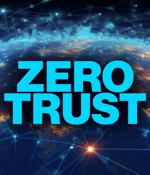Security News

Unlike conventional systems that often rely on perimeter defenses, zero trust adopts a more discerning philosophy, treating every user, device, and transaction as untrusted by default. In this Help Net Security round-up, we present segments from previously recorded videos in which cybersecurity experts emphasize the importance of zero trust in the context of cybersecurity, underscoring its crucial role in mitigating the risks posed by cyber threats and evolving attack vectors.

It's vital the credentials stored within are kept secure - so how can we apply zero trust principles towards keeping our Active Directory secure? Password reset processes are often a point of vulnerability in an organization's Active Directory security, especially when they involve sending a reset link or code to the user's email or phone.

You've probably heard it before: zero trust is not a single product, but a security strategy that follows the principle of "Never trust, always verify". Implementing zero trust means an overall change in technology and architecture, and doing it one step at the time.

In this Help Net Security interview, Phil Vachon, Head of Infrastructure in the Office of the CTO at Bloomberg, discusses the varying definitions of zero trust among security professionals and companies, emphasizing its broad design philosophy. Why does the definition of zero trust vary so significantly among security professionals and companies? How do these variations impact companies' approach toward implementing zero trust?

Digital expansion inevitably increases the external attack surface, making you susceptible to cyberthreats. Threat actors increasingly exploit the vulnerabilities stemming from software and...

Nearly all organizations rely on the cloud to store sensitive data and run critical systems. 93% agree that zero-trust segmentation is essential to their cloud security strategy.

Goerlich emphasizes the role of organizational culture in successfully adopting zero trust, outlines strategies for cultivating a supportive culture, and talks about future trends in the evolution of the zero-trust model. We've seen measurable increases in the security function's ability to keep up with the business, adapt to external events, and create a security culture.

ThreatLabz focused on understanding IoT device activity and attributes via device fingerprinting and analyzing the IoT malware threat landscape. By adopting a zero trust architecture, organizations can gain visibility into IoT device traffic and minimize IoT security risks.

Ten years ago, zero trust was an exciting, innovative perspective shift that security experts were excited to explore; today, it's more likely to be framed as an inevitable trend than as a mere option on the security menu. While adopting ZTNA certainly is a major project, for which business leaders should anticipate long timelines and complicated decisions, it should also be seen as an important tactic for reaching a more sustainable financial footing.

Google announced security enhancements to Google Workspace focused on enhancing threat defense controls with Google AI. At a Google Cloud press event on Tuesday, the company announced Google Cloud's rollout over the course of this year of new AI-powered data security tools bringing zero-trust features to Workspace, Drive, Gmail and data sovereignty.The focus of the new enhancements across Google Drive includes a slew of zero-trust aligned, AI-powered enhancements to its cloud-native architecture, according to Google, which said AI will drive automated data labeling and classification to defend against exfiltration attempts by threat actors.